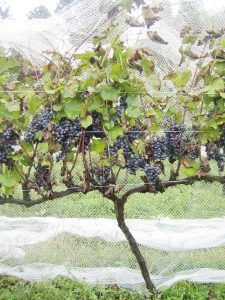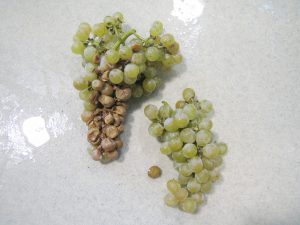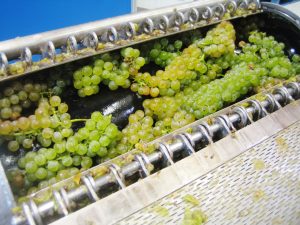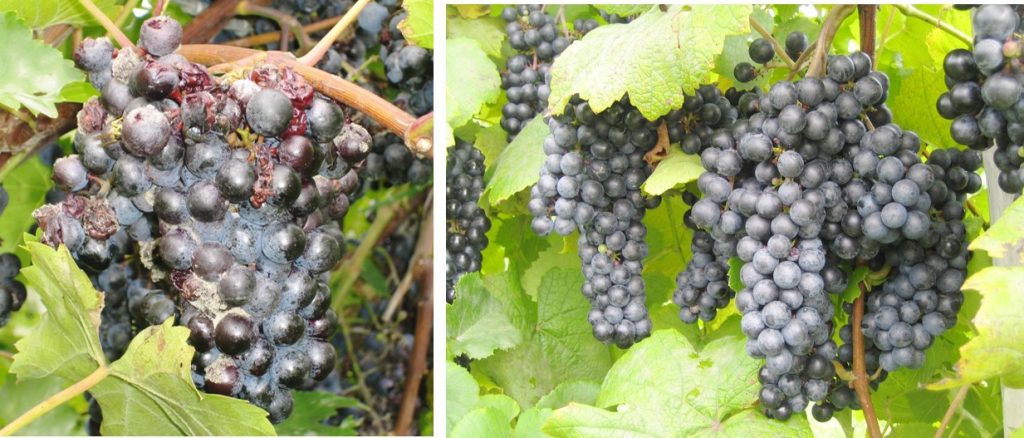With Hurricane Florence threatening most of the Eastern seaboard and Mid-Atlantic, I think it’s an important time to take a moment and communicate a practical plan for your winery staff. There’s a few days left to get organized, and not a moment to waste.
Remember that keeping your family, employees, and families safe is the most important part of these natural disasters. If you’re in an area under severe threat or emergency, please take all necessary precautions.
As far as the vintage is concerned, let’s take a second to review lessons learned in 2011 and practical action steps to take now for vintage 2018.

A Tale of Two Vintages: 2011 and 2018
My first real harvest in Pennsylvania was vintage 2011.
It had been a hot, dry growing season in 2011. I specifically recall visiting vineyards and wineries across Pennsylvania (PA) and hearing growers express a need for rain by mid-July.
Everyone’s cries for rain were answered in 2011. Answered exponentially, actually.
The first significant rainfall to hit us in late August was Hurricane Irene. Most of the rivers in the Eastern part of the state were flooded quickly as inches upon inches poured upon most of the Eastern seaboard and into the mainland. To add insult to injury, Tropical Storm Lee traveled up from the southern mainland in the beginning of September. I actually remember driving back and forth between State College and Harrisburg for a meeting, confronted with waterfalls of water pouring onto the highways from higher elevations. Additionally, the Susquehanna River was at levels I had never seen prior.
I recall pondering about how my time in Napa, where I had moved from, could possibly prepare me for what vintage 2011 was turning into.
Now here we are in 2018 and a similar story has emerged. Some growers recently told me they have received over 21 inches of rain in the last few weeks with no end in sight on when the rain will stop.
Depending on your location, the ground may already be saturated. You may not have seen sun in the past few days. You may be bracing for the worst as the hurricane approaches shore. You may be wondering what to do.
Viticulturally, I really don’t know what the answers are. However, I tell the story of vintage 2011 to remind us that we got through it.
Winemakers were devastated in 2011. By November, most people could not be more thankful the harvest was over. It was messy and tiring. The vintage caused a lot of unrest.
But you know what? By Spring, most of us were emerging from our dark, cold cellars and admitting the wines weren’t half as bad as we thought they would be. They may not have been phenomenal, but they were good enough to reflect a story about vintage 2011.
To be fair, 2011 taught me a lot of winemaking lessons and provided me with utmost respect for those vintners that powered through. While there are currently some key differences between 2011 and 2018, it’s apparent that 2018’s story has yet to be told. And with that in mind, I’ll share a few of my 2011 winemaking lessons that may benefit you over the next few days and into the remainder of vintage 2018.
1. Most whites benefit from less rain.
Now, as a consultant, I’m making serious considerations as to which whites we may be able to bring into the cellar and start fermentation before the series of rains hit. There’s almost two full weeks of rain in the forcast for my area; it’s time to make those practical decisions and assess if some of the white grape varieties can hold up for another 2-plus weeks.
In 2011, I found white wine varieties from grapes picked before heavy rainfall retained better intensity of aromatics and flavors compared to many picked immediately after the rainfall. The whites that were picked earlier, despite the lack of sugar accumulation (ranging from 16 °Brix to 18 °Brix in some varieties). However, maturity had to be far enough advanced to avoid obvious green flavors. Many white varieties picked later were well fermented and clean, but had an overall neutral aroma and flavor.
This picking decision will ultimately depend on the variety, conversations with your grower, and considerations about what to do in the event of power loss or flooding while primary fermentation progresses.
Fermenting neutral, clean white wines is not the end of the world. Considerations on blending, branding, and labeling those wines can occur post-harvest when the situation is less time sensitive.
After wines are fermented, Dr. Molly Kelly from Penn State Extension suggests adding fresh, unfermented juice (potentially from an alternative region) to a neutral base wine to liven the aromatics of the finished wine. Along these lines, purchases of out-of-state fruit, juice, or concentrate (within the legal boundaries of your region) may offer blending options to enhance your 2018 wine portfolio. This may be an option for some wineries, but not for others that are branded on local or estate wines only. Furthermore, additions of these wines provide educational opportunities for your consumers.
2. Choose a good yeast, monitor fermentation, and maintain good nutrient addition strategies.
At this point, a winemaker’s goal is to produce as clean a wine as possible. If you haven’t thought twice about your yeast and nutrient strategies, I would put this at the top of the priority list. Get some backup products ordered that may be necessary for treating rots or enhancing compromised fruit.
Review the yeast you have available. Look for quick, robust fermenters (typically Saccharomyces bayanus strains) and/or those that require little nitrogen additions, as some rots can quickly reduce the available nitrogen.
Remember to take a photo assessment of your fruit, especially compromised fruit. This can help with memory recall if winemaking problems arise later.

Measure YAN prior to inoculation, and treat accordingly. Many winemakers have had success with nutrient products like Nutriferm Arom and Fermaid O for tricky fermentations that run risks of hydrogen sulfide development or getting stuck.
Monitoring fermentation is crucial. I recommend checking white fermentations at least once per day, and around the same time each day to evaluate temperature and Brix. Take note of any off-odors that develop during fermentation. Make the appropriate nutrient additions to get through fermentation as easily and cleanly as possible. Move wines off gross lees quickly. If the grapes were compromised, avoid letting the wines sit on fine lees as well.
3. Minimize extraction of compromised fruit. Get wines, produced from compromised fruit, off of their lees.
This could be one of the most proactive steps a winemaker can take in extreme-rain vintages.

Minimizing skin contact time from compromised fruit reduces extraction of rot byproducts (e.g., aroma compounds, proteins, pectins, glucans, etc.). Of course, decreasing skin contact time also minimizes the extraction of potential beneficial components.
Take time to invest in sorting pre-fermentation. Selecting the cleanest fruit for crushing/destemming and through fermentation. While this is a big time investment for your cellar staff, it can be a beneficial practice in the long run.
Whole cluster pressing (as opposed to crushing and destemming first) is also an option to be considered. Avoid over-pressing. While yield will likely be affected, in these vintage years I would argue it is better to have less of a higher quality product than a large volume of a problematic wine.
Whole cluster pressing may be an option for some red varieties that can be processed into rosés. Otherwise, minimizing skin contact time during red wine fermentation is an additional option. The less rot components that are extracted, the easier the wine’s production will be.
Make sure to consider your juice treatments and fining agents carefully. It’s possible to reduce the concentration of byproducts and influence of various rots through key fining or settling decisions. These steps can prevent problems from arising further down the production line.
4. Develop alternative strategies for your red varieties now.
I imagine many red varieties may have some ways to go. While some picking decisions may vary based on the variety, for the most part, the reds will have to go through the rains.
Nonetheless, once your white winemaking plan is established and you’re fully prepared for the pending hurricane, use some of the “down time” make some production decisions about your incoming red fruit: both about when to pick and how to handle it in the winery. Considering and updating your sanitation strategies may be essential. For compromised fruit, options like less skin extraction and co-inoculation of yeast and malolactic bacteria may help retain fruit aromatics and wine quality. Consider your options or review with your winemaker or winemaking consultant.
5. Plan on filtration issues.
One frequent issue that comes from rotten fruit is filtration issues later on in production.
While this may not be in your immediate horizon, taking steps to reduce pectins and glucans prior to fermentation can help minimize latent clarification challenges. Order those available enzymes and fining agents now.
Many suppliers now offer enzyme selections that are effective in the wine as well, just in case filtration becomes a problem at a later winemaking stage.
Additional solutions for rainy harvests.
While these are broad suggestions, the point is to remember that we can still make decent wine through this vintage if proper considerations are taken and decisions are made in a timely manner.
These are years in which the vineyard does not hand deliver us our wine. With good preparation from the vineyard, these are the years in which winemakers have the potential to shine.

If you still need help, there’s a lot of solutions and winemaking strategies – both free or for a small fee – available to those that may feel less than confident during this rainy harvest. If you know you are going to need some extra assistance in winemaking decisions associated with compromised fruit, I will be available for inquiries through the next few weeks. Inquire today for my available rates and phone number (info@dgwinemaking.com).
Gray Mold/Botrytis
Dr. Molly Kelly from Penn State Extension recently published an excellent Extension article, “Botrytis Bunch Rot: Winemaking Implications and Considerations” that provides further detail touched upon in this post. It also updates my previous Extension post, “Fermenting with Botrytis 101.” Molly’s article outlines issues with Botrytis rot, why it becomes a winemaking challenge, and tips on how to address it in the winery. Dr. Murli Dharmadhikari from Iowa State University also has a great summary on Botrytis cinerea in Winemaking.
As part of the DGW Community, you can also reference “Processing Decisions: Dealing with Botrytis, Gray Mold.”
Sour Rot
I have previously written an article on sour rot, published through Penn State Extension titled, “Managing Sour Rotted Fruit in the Cellar.” This is a tricky and frustrating rot to work with in the cellar, but these are the vintages where we tend to see a higher incidence of sour rot. If you are dealing with sour rot, but have had little exposure to it previously, The Academic Wino has pulled apart a prior study on sour rot and how it affects wine.
Fermentation Strategies from Suppliers
Both Scott Labs and Enartis USA (Enartis Vinquiry) offer winemaking strategies for:
- White or rosé winemaking from rot infected grapes: Scott Labs, Enartis USA
- Red winemaking from rot infected grapes: Scott Labs, Enartis USA
- White or rosé winemaking from grapes with powdery mildew: Enartis USA
- Red winemaking from grapes with powdery mildew: Enartis USA
While this goes without saying, sanitation is clearly most important during these wetter vintages.
